The AMD Zen and Ryzen 7 Review: A Deep Dive on 1800X, 1700X and 1700
by Ian Cutress on March 2, 2017 9:00 AM ESTBenchmarking Performance: CPU System Tests
Our first set of tests is our general system tests. These set of tests are meant to emulate more about what people usually do on a system, like opening large files or processing small stacks of data. This is a bit different to our office testing, which uses more industry standard benchmarks, and a few of the benchmarks here are relatively new and different.
PDF Opening
First up is a self-penned test using a monstrous PDF we once received in advance of attending an event. While the PDF was only a single page, it had so many high-quality layers embedded it was taking north of 15 seconds to open and to gain control on the mid-range notebook I was using at the time. This put it as a great candidate for our 'let's open an obnoxious PDF' test. Here we use Adobe Reader DC, and disable all the update functionality within. The benchmark sets the screen to 1080p, opens the PDF to in fit-to-screen mode, and measures the time from sending the command to open the PDF until it is fully displayed and the user can take control of the software again. The test is repeated ten times, and the average time taken. Results are in milliseconds.
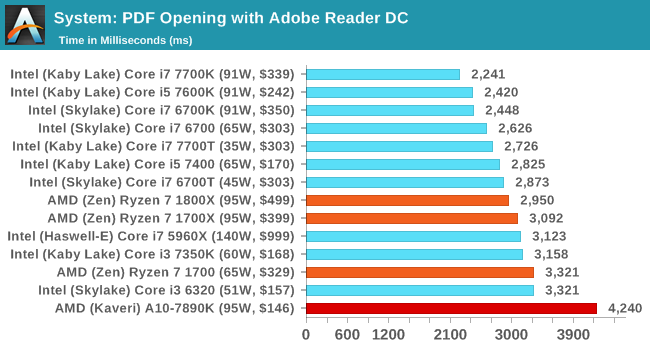
FCAT Processing
One of the more interesting workloads that has crossed our desks in recent quarters is FCAT - the tool we use to measure stuttering in gaming due to dropped or runt frames. The FCAT process requires enabling a color-based overlay onto a game, recording the gameplay, and then parsing the video file through the analysis software. The software is mostly single-threaded, however because the video is basically in a raw format, the file size is large and requires moving a lot of data around. For our test, we take a 90-second clip of the Rise of the Tomb Raider benchmark running on a GTX 980 Ti at 1440p, which comes in around 21 GB, and measure the time it takes to process through the visual analysis tool.
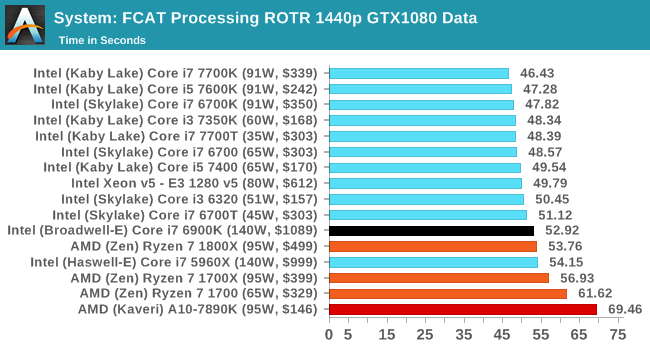
3D Particle Movement v2.1
This is the latest version of the self-penned 3DPM benchmark. The goal of 3DPM is to simulate semi-optimized scientific algorithms taken directly from my doctorate thesis. Version 2.1 improves over 2.0 by passing the main particle structs by reference rather than by value, and decreasing the amount of double->float->double recasts the compiler was adding in. It affords a ~25% speed-up over v2.0, which means new data.
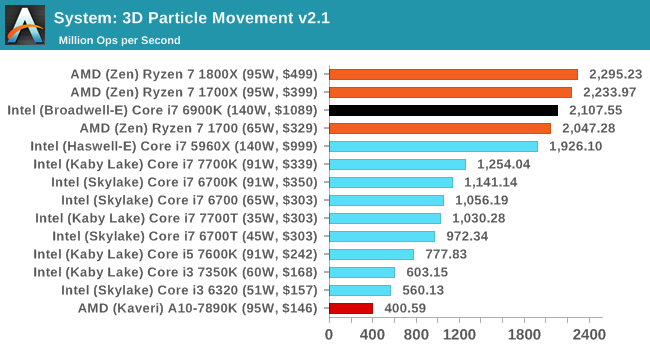
DigiCortex 1.16
Despite being a couple of years old, the DigiCortex software is a pet project for the visualization of neuron and synapse activity in the brain. The software comes with a variety of benchmark modes, and we take the small benchmark which runs a 32k neuron/1.8B synapse simulation. The results on the output are given as a fraction of whether the system can simulate in real-time, so anything above a value of one is suitable for real-time work. The benchmark offers a 'no firing synapse' mode, which in essence detects DRAM and bus speed, however we take the firing mode which adds CPU work with every firing.
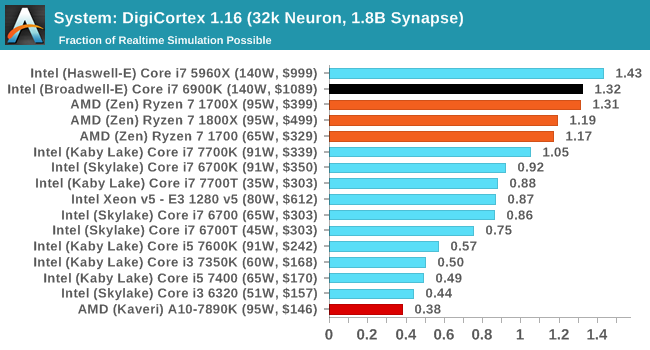
Agisoft Photoscan 1.0
Photoscan stays in our benchmark suite from the previous version, however now we are running on Windows 10 so features such as Speed Shift on the latest processors come into play. The concept of Photoscan is translating many 2D images into a 3D model - so the more detailed the images, and the more you have, the better the model. The algorithm has four stages, some single threaded and some multi-threaded, along with some cache/memory dependency in there as well. For some of the more variable threaded workload, features such as Speed Shift and XFR will be able to take advantage of CPU stalls or downtime, giving sizeable speedups on newer microarchitectures.

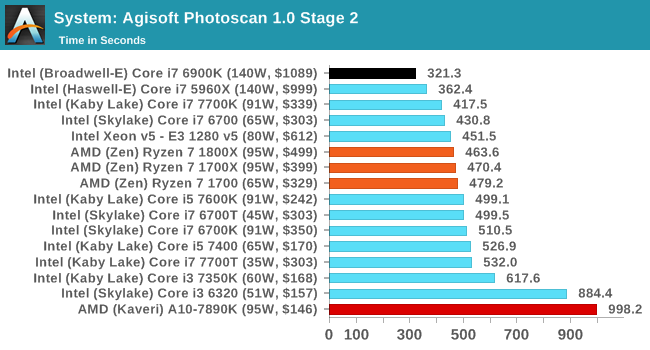
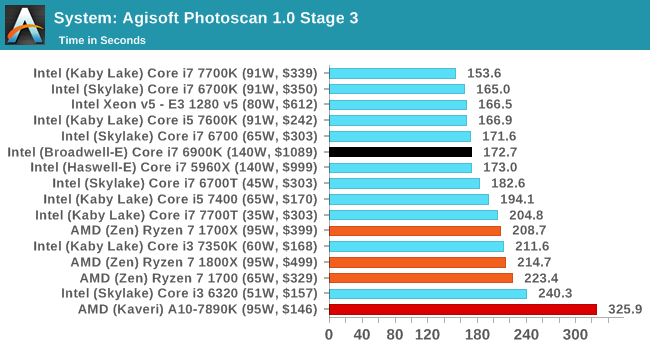
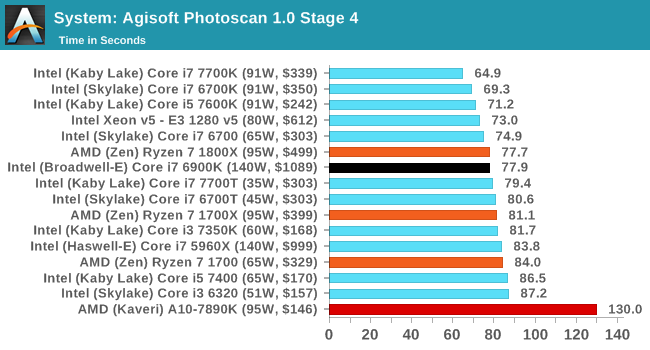
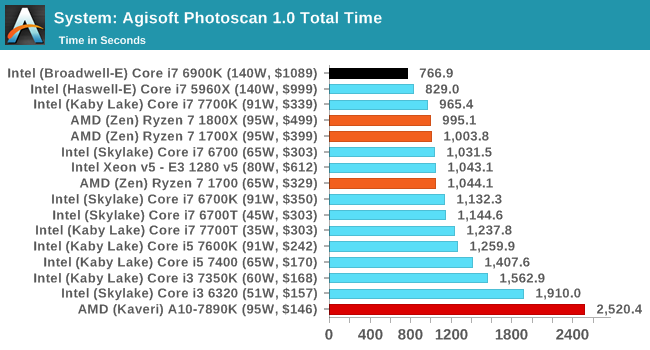










574 Comments
View All Comments
zangheiv - Thursday, March 2, 2017 - link
Hard to believe how a company like intel that repeatedly and knowingly engaged in illegal acts and other tactics to monopolize the market and cheat the consumers into high-prices, can still have dumb happy consumers after Ryzenlmcd - Thursday, March 2, 2017 - link
Some people like 256-bit vector ops I guess :-/ who would've guessed?Ratman6161 - Thursday, March 2, 2017 - link
Have to agree. To me, the i7-7700K seems like the better bargain right now. Then again, I'm looking at a $329 I7-6700K motherboard and CPU bundle and the 7700K isn't really all that much of an upgrade from the 6700K. But in the final analysis, after all this reading, I'm still not seeing anything that makes me want to rush out and replace my trusty old i7-2600K.Meteor2 - Friday, March 3, 2017 - link
+1. Maybe, as Rarson says above, a 4C/8T Zen might clock fast enough to challenge the 7700K. But in the workloads run at home, the 1800X does not challenge the (cheaper) 7700K.HPC and data centre are completely different and here Zen looks like it has real promise.
Meteor2 - Friday, March 3, 2017 - link
...Sadly the R5s are clocked equally low.https://www.google.co.uk/amp/wccftech.com/amd-ryze...
Limited by process, I guess.
Cooe - Sunday, February 28, 2021 - link
Again. You're an absolute idiot for thinking that the only "workloads done at home" are 1080p gaming & browsing the web.... You are so out of touch with the desktop PC market, it's almost unbelievable. Here's hoping you were able to aquire some common sense over the past 4 years.cmdrdredd - Saturday, March 4, 2017 - link
" I'm still not seeing anything that makes me want to rush out and replace my trusty old i7-2600K."I agree with you. I have an overclocked 3570k and I don't see anything that makes me feel like it's too old. I'm mostly gaming on my system when I use it heavily, otherwise it's just general internet putzing around
Jimster480 - Thursday, March 2, 2017 - link
Sorry but this is not the case.This is competing against Intel's HEDT line and not against the 7700k.
2011v3 offers more PCI-E lanes only if you buy the top end CPU (which ofc isn't noted in most places) a cheaper chip like the 5820k for example only offers like 24 lanes TOTAL. Meaning that in price comparison there is no actual comparison.
Ratman6161 - Thursday, March 2, 2017 - link
Well, whomever is trying to compete against, I7-7700K is about the top of the price range I am willing to spend. So Intel's 2011V3 lineup isn't in the cards for me either. AMD really isn't offering anything much for the mid range or regular desktop user either. In web browsing, office tasks, etc, their $499 CPU is often beaten by an i3. Now, the i3 is just as good as an i7-6900K too and in at least one test the i3 7350K is top of the charts. Why does this matter? Well, where does AMD go from here? If the i3 out performs the 1800x for office tasks, what will happen when they cut it to 4 cores to make a cheaper variant? Seems like they are set up for very expensive CPU's and for CPU's they have to sell for next to nothing. Where will their mid range come from?silverblue - Thursday, March 2, 2017 - link
Something tells me that if I decide to work on something complicated in Excel, that i3 isn't going to come anywhere near an R7. Besides, the 4- and 6-core variants may end up clocked higher, we don't know for sure yet.